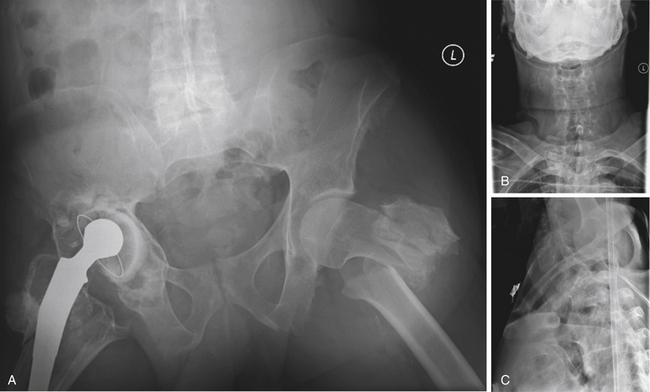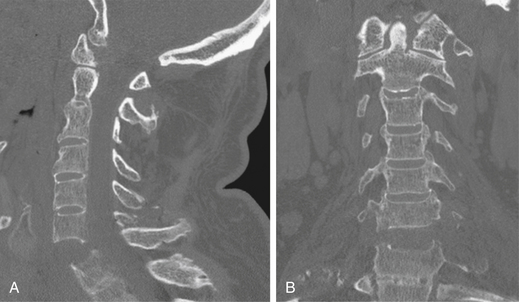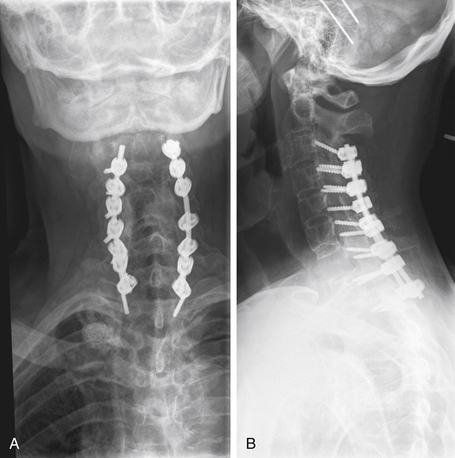Chapter 69 Nonoperative Management and Treatment of Spine Injuries
At the Scene
According to Advanced Trauma Life Support (ATLS) protocol, life-threatening compromise to airway, breathing, and circulation should be promptly addressed. Although the greatest risk for spinal cord injury occurs at the time of high-energy impact, neurologic deficits can develop thereafter during treatment. In 1983 Podolsky et al. reported that up to 25% of spinal cord injuries had been caused by or aggravated after the patient had come under medical care.1 Immobilization of the injured spine is the key to preventing such catastrophic decline.
At the Hospital
The patient should arrive in the emergency department on a backboard with a cervical collar in place. In the face of a global instability, motion can still occur in spite of all attempts at rigid immobilization. The patient should be moved on and off the backboard as few times as possible until the stability of the spine can be adequately assessed. For most injuries the collar provides an increased level of stability. However, it does not provide complete immobilization.2 With a complete ligamentous disruption, the collar has minimal effect. The person stabilizing the spine is much more significant in restricting motion.3
The risk of decubitus ulceration is directly proportional to the length of time on a backboard—8 hours on a backboard is associated with a 100% likelihood of a decubitus ulcer.4 The patient should be moved from the board as soon as possible. Appropriate spine immobilization must be continued at all times.
Contrary to all available evidence suggesting that the log roll is an ineffective and potentially dangerous technique for spine immobilization, it is still almost universally used. In fact, studies conducted prior to 2004 showed dramatic and unacceptable motion with a log roll.5 Recently, many studies have reevaluated this controversial subject. Compared with any other method of transfer, the log roll maneuver has been shown to cause more segmental motion at the level of the unstable, injured segment.6–13 Lift and slide techniques are far superior since they tend to create less motion at the injured segment.10
Imaging Studies
Following review of the initial CT scan, another assessment of spinal stability can be performed. When a closed reduction of a dislocated segment is needed, it should be performed expediently in the awake and alert patient. Serial neurologic examinations are performed during such a reduction maneuver. If the patient is obtunded or reliable neurologic examinations are impossible, then an emergent MRI should be obtained prior to attempting reduction to rule out significant disc herniation.14
Anteroposterior and lateral radiographs of the cervical, thoracic, lumbar, and sacral spine are standard imaging studies obtained in cases of high-energy impact with suspected spinal injury. Distracting injuries can often mask symptoms secondary to significant spine injury, and meticulous assessment of the spine must always be performed (Figs. 69-1 to 69-3). It is necessary to image the entire spinal column due to a 10% incidence of noncontiguous spinal injuries.15 Specific injury mechanisms and fracture patterns should prompt the treating team to search for commonly associated nonspinal injuries. Flexion-distraction injuries are highly associated with potentially life-threatening intra-abdominal injuries, so these must be ruled out. Patients with transverse process fractures at L5 have a 61% incidence of a pelvic fracture.16 Falls from a height with resulting burst fractures are often associated with significant lower-extremity fractures, in particular those of the tibia and calcaneus.
Closed Reduction of the Cervical Spine
Decompression of the spinal cord through closed reduction should be performed as soon as the patient can medically tolerate it. Closed reduction is a means of reducing cervical spine deformity, indirectly decompressing neural elements, and providing stability. It has been shown to be safe and can dramatically improve neurologic status if performed within the first few hours following injury. In animal studies, Carlson et al. showed that decompression within 3 hours showed better and quicker neurologic recovery.17 A small series of patients with no cord function who received reduction in an emergent manner immediately began to recover.18 Although this is anecdotal, it is extremely important. The timing question is answered after consideration of the risk-benefit ratio between waiting to obtain a prereduction MRI and proceeding directly with reduction.
Considerable controversy surrounds the order of the reduction and obtainment of an MRI in an acute cervical spine dislocation. Eismont et al. reported on a series of six patients who roentgenographically demonstrated herniation of an intervertebral disc with marked protrusion of disc material into the spinal canal following subluxation or dislocation of a cervical facet. For the first patient in this series, no myelogram or CT scan was performed, and the patient awoke with complete quadriplegia following dorsal open reduction and internal fixation. Following a myelogram and ventral decompression surgery, the cause was identified as an extruded intervertebral disc. The authors recommended obtaining an MRI in all patients prior to attempted closed reduction and definitive surgery.19–21 Several other cases with neurologic deficits after open reduction under general anesthesia have been reported.20,21 There have also been reports of progression of neurologic deficits during traction while the patient was awake and participating that later resolved.22
The group from Thomas Jefferson University advocates performing immediate closed reduction in the patient that is awake and can reliably participate in serial neurologic examinations. Vaccaro et al. published their series of 11 patients who underwent successful awake closed reduction without any neurologic worsening. In their series, two patients had herniated discs prior to reduction, and another five had herniated discs following reduction.14 Darsaut et al. attempted to determine the effect of disc herniation during closed reduction in a series of 17 patients who had a cervical dislocation that was reduced under MRI monitoring. They demonstrated that at least as a research tool this technique was possible.23
A commonly used algorithm is based on the patient’s neurologic status. If the patient is unable to participate reliably in the physical examination, then an MRI is obtained as expediently as possible. In cases of mild radicular deficit, MRI has the principal disadvantage of requiring vital time. If the patient has a significant spinal cord injury, the risk is that the cord will remain compressed for a longer time. Therefore, if the patient has minimal or no neurologic dysfunction, an MRI should be obtained. If the patient has an American Spinal Injury Association (ASIA) A, B, or C injury and is able to cooperate with the reduction and serial neurologic examinations, consideration should be given to an immediate, rapid reduction. In this situation, the MRI would be obtained after reduction.
Reduction Techniques
Reduction of a cervical spine dislocation must be performed under image guidance and in a very controlled manner. Gardner-Wells tongs are applied with the pins placed 1 cm above the pinna of the ear just below the equator of the head. Pins are tightened to 3.6 kg of pressure. This is indicated once the precalibrated indicator pins protrude a measured amount. If using weights over 25 kg, titanium pins and MRI-compatible tongs are insufficient. Weights of over 60 kg have been used safely for closed reduction of such injuries.24 In such instances, stainless steel pins or two sets of tongs must be used. Another option includes the use of a halo that provides four titanium pins to distribute the forces over more pins. The major disadvantage of stainless steel pins is their MRI incompatibility.
Timing of Surgical Intervention
Debate continues over the appropriate timing of traction or surgery in cases of acute spinal cord injury. It is difficult to demonstrate improvement in neurologic function from acute surgical intervention.25 Complete cord injuries and neurologically intact patients are very likely to remain neurologically unchanged with appropriate surgical or nonoperative care. Incomplete lesions typically improve with either surgical or nonsurgical care. Late surgery with decompression of the spinal canal in incomplete cord injuries has been shown to improve neurologic function even several years following the traumatic event.26,27 In the acute setting, there is sparse and unconvincing evidence supporting early surgery. Surgery for the purpose of spinal canal decompression in a neurologically intact patient is difficult to defend considering that several series have shown dramatic spinal canal remodeling over time in patients with and without surgery.28–35
Upper Cervical Injuries
Occipitocervical injuries are most often fatal and typically found postmortem. When encountering a patient with such an injury, the treating physician must be vigilant about the diagnosis to ensure the patient’s survival. Initially, such patients should be meticulously immobilized on a backboard with a collar and the head secured with sandbags and tape. Atlanto-occipital disassociation is then stabilized with a halo vest until definitive surgical stabilization is performed.36 It should be noted that traction for type II injuries (axial distraction) can be catastrophic and is strictly contraindicated. The injury is treated with dorsal occipital cervical fusion with at least 3 months of halo vest immobilization. Occipital condyle fractures and Jefferson or atlas ring fractures are typically managed with an orthosis or a halo.37
Odontoid fractures depend on the injury itself. Many can be treated with a rigid orthosis or halo vest. Type I and type III fractures typically heal uneventfully and have a good prognosis without surgery. Transverse type II fractures through the waist of the odontoid have a high associated nonunion rate and are therefore the ideal fractures for surgical treatment. A dorsally displaced odontoid fracture is more likely to be treated with surgery.38–43 Polin reported on a series of patients treated with a rigid collar as opposed to a halo. More nonunions were associated with the type II fractures. However, there was no statistically significant difference between the orthoses used.43 Chronic odontoid nonunions in the elderly can often be followed and may not require surgical intervention. In a series of persistent nonunions, no progression of atlantoaxial instability or neurologic deficit was noted or myelopathic symptoms during the follow-up period.44
At later reassessment of stability, transverse ligament ruptures can be managed in an orthosis if a bony avulsion occurs.45,46 If successful, this avoids the significant loss of motion following an atlantoaxial arthrodesis. Dickman et al. demonstrated a 100% failure to heal in complete ligamentous disruptions. These injuries often result in a significant incidence of neurologic injury, and there is frequent association with other upper cervical injuries. They should be treated with C1-2 arthrodesis.47
The vast majority of other axis injuries can be stabilized with an orthosis or a halo vest. Traumatic spondylolisthesis of the axis most commonly occurs secondary to a hyperextension and axial load mechanism. Neurologic deficit rarely occurs, with the exception for the atypical fracture that occurs ventral to the dorsal vertebral body cortex.48 These atypical fractures may require surgery to prevent neurologic decline. Severe hangman’s fractures with instability through the C2-3 disc space require surgery. Most other axis injuries can be managed successfully nonoperatively.37,40,49–52










